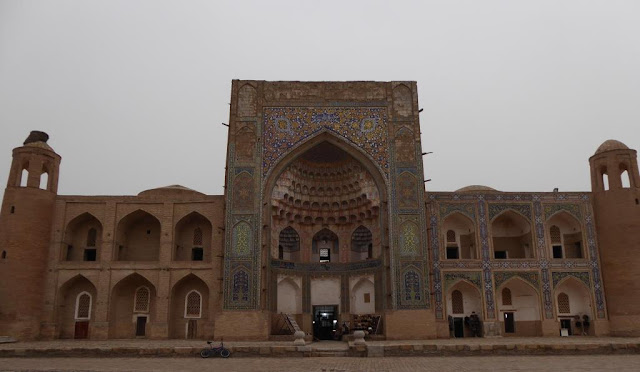Buchara, bathing in the past
As the
train crosses the steppe, I stare out the window and can imagine the caravans
that exchanged valuables and insights between East and West centuries ago. I am
on my way to Buchara, an Uzbek city on the Silk Road. An oasis in the middle of
the steppe. I am still impressed by the splendour and history of Samarakand,
another city here in Uzbekistan. A gem, which Alexander the Great already spoke
of with high praise.
It is foggy
when I arrive in Buchara. The railway station, like the others I have already
seen in this country, is a feat of bombastic Soviet architecture. It is still a
long way to the city itself. Because when the Russians built the Trans-Caspian
railway in 1888, there was so much protest from the local administration that
the station was built 10km outside the city.
All that walking makes me tired and I decide to visit the Kunjak Hammam, a 16th century bathhouse. This building too is below street level. I step through the low door and down a staircase into a kind of living room, with an impressive ceiling. To the right, a woman is sleeping on a stretcher. In front of me is a wall of wooden cabinets showing a number here and there. In the middle is a table, on a red carpet. Yes, I can go to the toilet first. I have to cross a dusty courtyard. Squat above two wooden boards. The plumbing here has not kept up with the times either.
Inside, I
am handed a cloth and towel. The woman helping me speaks only Tajik. Well, not
only, she also speaks Uzbek and Russian, like all the people here. But no
English. I understand her gestures, though. Undress, tie the cloth and come
with me.
We step down some more stairs and walk under successive domes to a room where it is hot and humid. The only light comes in through a small hole in the centre of the dome. A young girl lies on the warm floor. An older woman is washing herself. She occasionally asks the young girl for help. I am rinsed off with warm water, scrubbed and rinsed again. The water splashes around. Wonderful. I am taken to another room where I have to lie on a kind of brick raised platform. Massage. No, no Thai or Swedish techniques, but it's equally relaxing. Back to the bathing area. I am rinsed again. A scrub. Rinsed again. The floor is also rinsed and then I get to lie down on that blissfully warm floor too. The scoop with which the water was poured over me now serves as a headrest. I am now alone in the room. I close my eyes. I hear the radio playing in the distance, the music making its way through the ancient vaults. The tap drips. Every now and then a drop of condensation falls down from the ceiling. I think of all the women who have bathed here over the past centuries, giggling, exchanging stories.
After a
last rinse, there is another cup of tea with some sweets. I feel refreshed.






Comments
Post a Comment